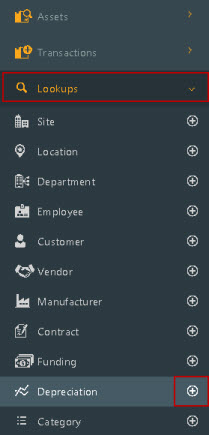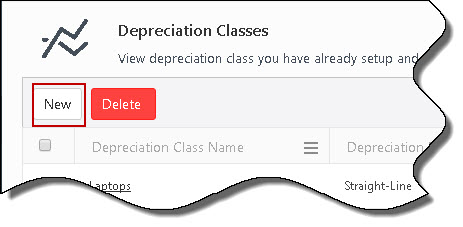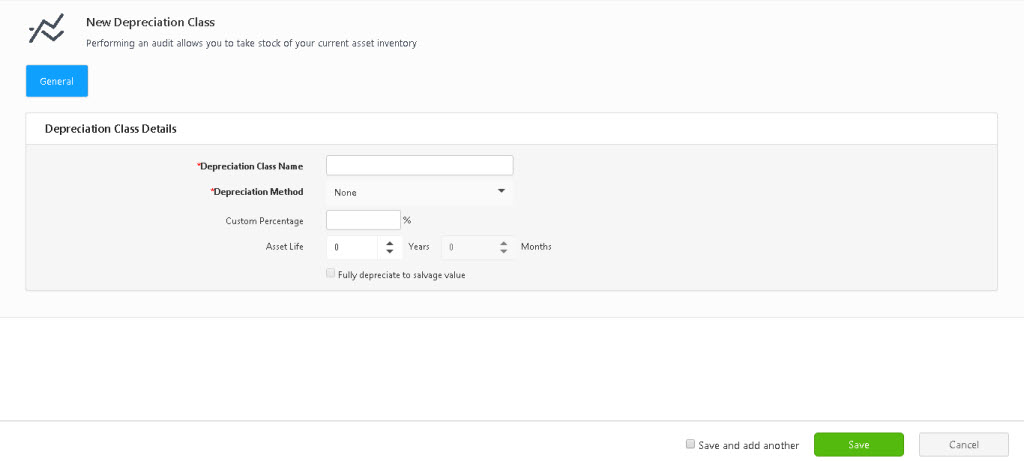

On the New Depreciation Class screen, you can set up a new depreciation class with a chosen method, custom percentage, and asset life.
 button.
button.
Or click on Lookups -> Depreciation -> New button.



Example: Formula - (purchase price of the asset – approximate salvage value) / estimated useful life of the asset.
Assume you buy a new computer for your business costing approximately $5,000. You expect a salvage value of $200 for selling parts when you dispose of it. Accounting rules allow a maximum useful life of five years for computers; in the past, your business has upgraded its hardware every three years, so you think this is a more realistic estimate of useful life, since you are apt to dispose of the computer at that time. Using that information, you would plug it into the formula: ($5,000 purchase price - $200 approximate salvage value) /3 years estimated useful life.
The answer, $1,600, is the depreciation charges your business would take annually if you used the straight line method.
Example: In our straight-line example, we calculated that a $5,000 computer with a $200 salvage value and an estimated useful life of three years would be depreciated by $1,600 annually. The first year, we have to compare this to the total amount to be depreciated, in this case, $4,800 [$5,000 base - $200 salvage value = $4,800]. Dividing $1,600 by $4,800, we discover the straight-line depreciation charge [$1,600] is 33.33% of the total depreciation amount [$4,800]. Using this information, we double the 33.33% figure to 66.67%.
In the first year, we would take $4,800 multiplied by .6667 to get a total depreciation charge of approximately $3,200. In the second year, we would take the same percentage [66.67%] and multiply it by the remaining amount to be depreciated. Continuing with the example, we find that $1,600 is the remaining amount to be depreciated at the start of the second year [$4,800 - $3,200 = $1,600]. Multiply 1,600 by .6667 to get $1,066. This is the depreciation charge for the second year – or not! Remember that once the depreciation charges dip below the amount charged using the straight-line method, the double declining balance should be scrapped and straight line immediately utilized. The straight line method called for charges of $1,600 per year. Obviously, the $1,066 charge is smaller than the $1,600 that would have occurred under straight line. Thus, the deprecation charge for the second year would be $1,600. The equation illustrates this method: depreciable base * (2 * 100% / useful life in years).
Example: 10 years useful life = 10 + 9 + 8 + 7 + 6 + 5 + 4 + 3 + 2 + 1 Sum of the years = 55
In the first year, the asset would be depreciated 10/55 in value [the fraction 10/55 is equal to 18.18%] the first year, 9/55 [16.36%] the second year, 8/55 [14.54%] the third year, and so on. Going back to our example from the straight-line method: a $5,000 computer with a $200 salvage value and 3 years useful life would be calculated as follows: 3 years useful life = 3 + 2 + 1 Sum of the years = 6.
Taking $5,000 - $200 we have a depreciable base of $4,800. In the first year, the computer would be depreciated by 3/6ths [50%], the second year, by 2/6 [33.33%] and the third and final year by the remaining 1/6 [16.67%]. This would have translated into depreciation charges of $2,400 the first year, $1,599.84 the second year, and $800.16 the third year. The straight-line example would have simply charged $1,600 each year, distributed evenly over the three years of useful life.
FAQs - Refer to Knowledgebase - Knowledgebase > Cloud > AssetCloud for FAQs. Example: Depreciation methods and process
Note: Use of the resources described here requires internet access.